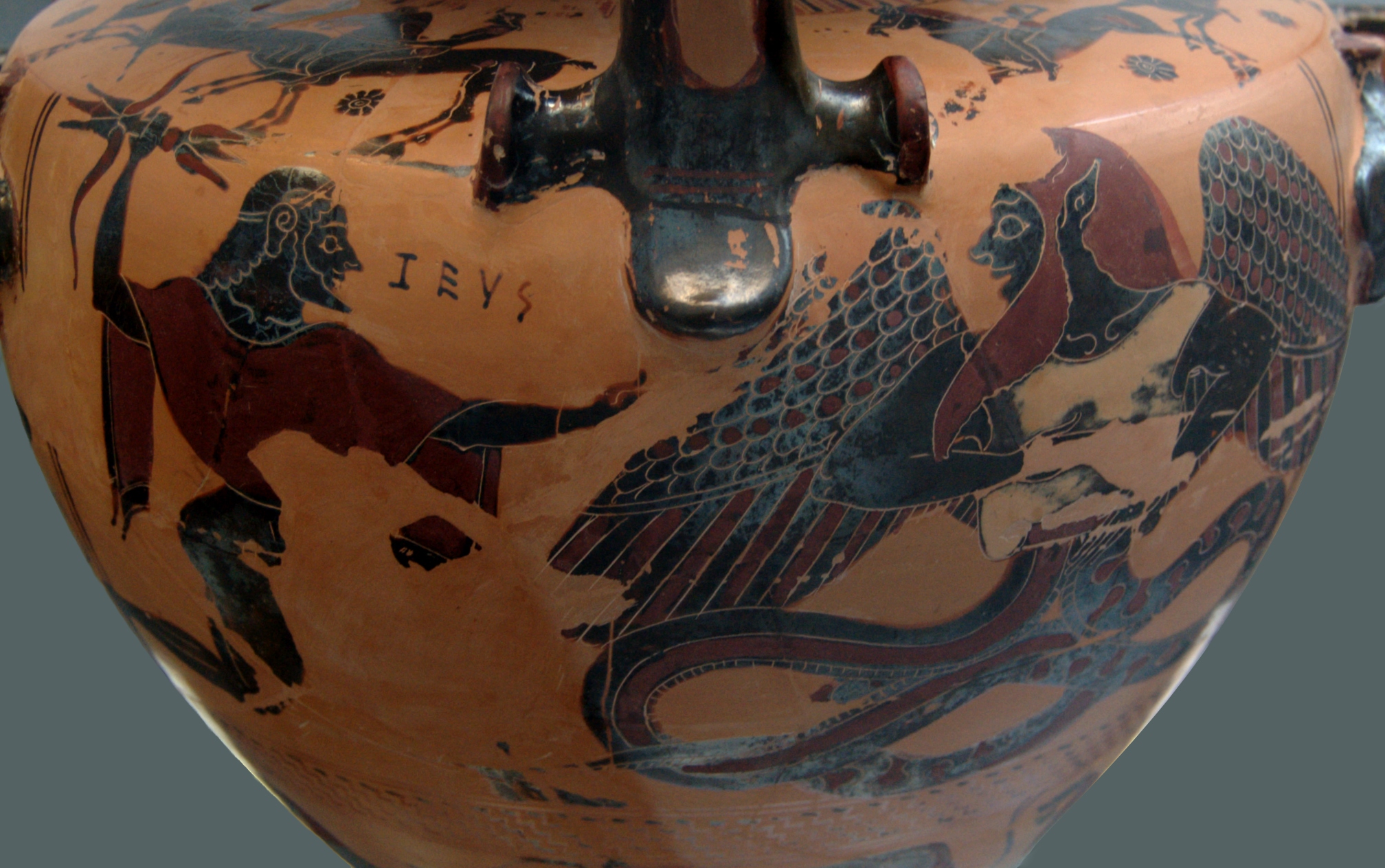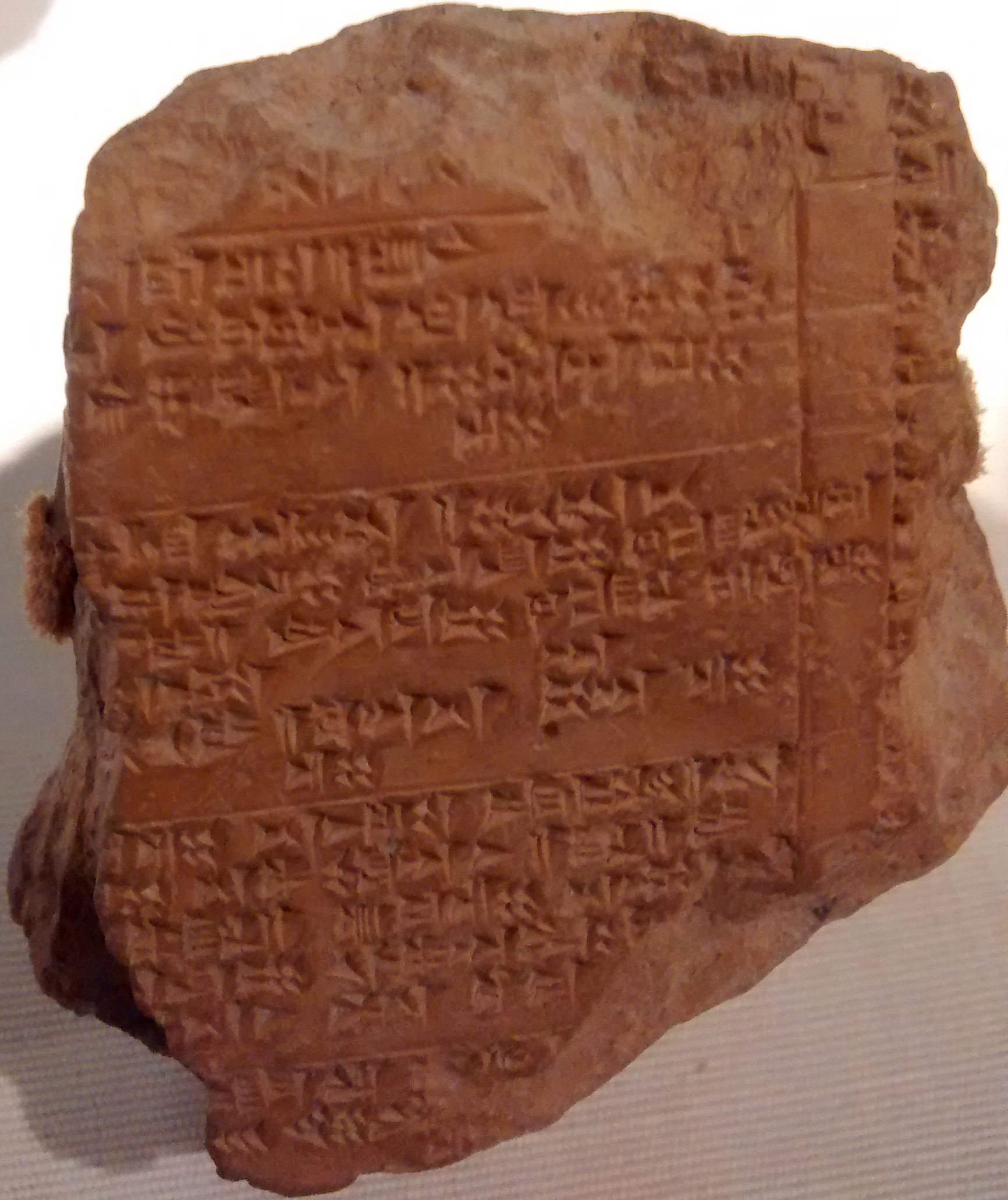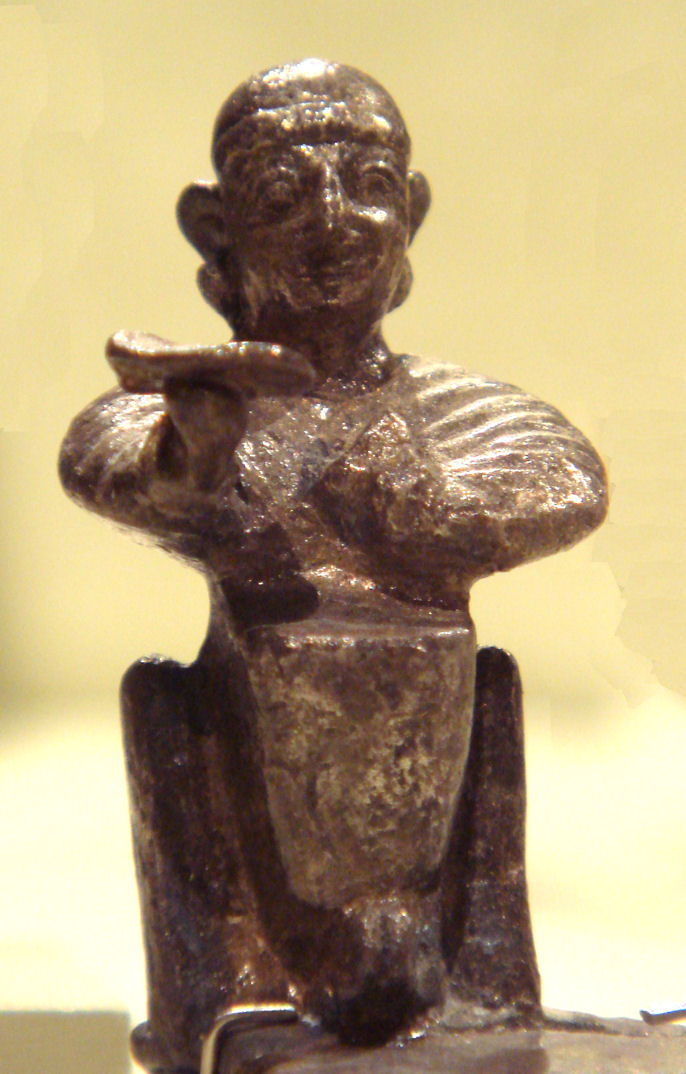|
Illuyanka
In Hittite mythology, Illuyanka was a serpentine dragon slain by Tarḫunz (), the Hittite incarnation of the Hurrian god of sky and storm. It is known from Hittite cuneiform tablets found at Çorum-Boğazköy, the former Hittite capital Hattusa. The contest is a ritual of the Hattian spring festival of Puruli. The myth is found in '' Catalogue des Textes Hittites'' 321, which gives two consecutive versions. Name ''Illuyanka'' is probably a compound, consisting of two words for "snake", Proto-Indo-European ''*h₁illu-'' and ''*h₂engʷeh₂-''. The same compound members, inverted, appear in Latin ''anguilla'' "eel". The ''*h₁illu-'' word is cognate to English '' eel'', and ''*h₂engʷeh₂'' to Sanskrit ahi. Narrative In the first version, the Storm God and Illuyanka fight, and the serpent wins. The Storm God then goes to the Hattian goddess Inaras for advice. Having promised to sleep with a mortal named Hupasiyas in return for his help, she devises a trap for th ... [...More Info...] [...Related Items...] OR: [Wikipedia] [Google] [Baidu] |
Typhon
Typhon (; , ), also Typhoeus (; ), Typhaon () or Typhos (), was a monstrous serpentine giant and one of the deadliest creatures in Greek mythology. According to Hesiod, Typhon was the son of Gaia and Tartarus. However, one source has Typhon as the son of Hera alone, while another makes Typhon the offspring of Cronus. Typhon and his mate Echidna were the progenitors of many famous monsters. Typhon attempted to overthrow Zeus for the supremacy of the cosmos. The two fought a cataclysmic battle, which Zeus finally won with the aid of his thunderbolts. Defeated, Typhon was cast into Tartarus, or buried underneath Mount Etna, or in later accounts, the island of Ischia. Typhon mythology is part of the Greek succession myth, which explained how Zeus came to rule the gods. Typhon's story is also connected with that of Python (the serpent killed by Apollo), and both stories probably derived from several Near Eastern antecedents. Typhon was (from ) also identified with the Egyptian god o ... [...More Info...] [...Related Items...] OR: [Wikipedia] [Google] [Baidu] |
Inara (goddess)
Inara or Inar, in Hittite mythology, was the goddess of the wild animals of the steppe and daughter of the Storm-god Teshub/ Tarhunt.Christopher SirenHittite/Hurrian Mythology REF 1.2 Retrieved April 27, 2010. She corresponds to the " potnia theron" of Greek mythology, better known as Artemis. Myths After the dragon Illuyanka wins an encounter with the storm god, the latter asks Inara to give a feast, most probably the '' Purulli'' festival. Inara decides to use the feast to lure and defeat Illuyanka, who was her father's archenemy, and enlists the aid of a mortal named Hupasiyas of Zigaratta by becoming his lover. The dragon and his family gorge themselves on the fare at the feast, becoming quite drunk, which allows Hupasiyas to tie a rope around them. Inara's father can then kill Illuyanka, thereby preserving creation. Inara built a house on a cliff and gave it to Hupasiyas. She left one day with instructions that he was not to look out the window, as he might see his famil ... [...More Info...] [...Related Items...] OR: [Wikipedia] [Google] [Baidu] |
Catalogue Des Textes Hittites
The corpus of texts written in the Hittite language consists of more than 30,000 tablets or fragments that have been excavated from the royal archives of the capital of the Hittite Kingdom, Hattusa, close to the modern Turkish town of Boğazkale or Boğazköy. While Hattusa has yielded the majority of tablets, other sites where they have been found include: Maşat Höyük, Ortaköy, Kuşaklı or Kayalıpınar in Turkey, Alalakh, Ugarit and Emar in Syria, Amarna in Egypt. The tablets are mostly conserved in the Turkish museums of Ankara, Istanbul, Boğazkale and Çorum (Ortaköy) as well as in international museums such as the Pergamonmuseum in Berlin, the British Museum in London and the Musée du Louvre in Paris. The corpus is indexed by the ''Catalogue des Textes Hittites'' (CTH, since 1971). The catalogue is only a classification of texts; it does not give the texts. One traditionally cites texts by their numbers in CTH. Major sources for studies of selected texts themsel ... [...More Info...] [...Related Items...] OR: [Wikipedia] [Google] [Baidu] |
Hattians
The Hattians () were an ancient Bronze Age people that inhabited the land of ''Hatti'', in central Anatolia (modern Turkey). They spoke a distinctive Hattian language, which was neither Semitic languages, Semitic nor Indo-European languages, Indo-European. Hattians are attested by archeological records from the Early Bronze Age and by historical references in later Hittites, Hittite and other sources. Their main centre was the city of Hattush. Faced with Hittite expansion (since 2000 BC), Hattians were gradually absorbed (by 1700 BC) into the new political and social order, imposed by the Hittites, who were one of the Indo-European-speaking Anatolian peoples. The Hittites kept the choronym, country name ("land of Hatti") unchanged, which also became the main designation for the Hittite state. Terminology Complex questions related to etymology of endonymic, native names for Hattians, their land, language and capital city (Hatti, Hattili, Hattush) are debated among scholars. L ... [...More Info...] [...Related Items...] OR: [Wikipedia] [Google] [Baidu] |
Tiamat
In Mesopotamian religion, Tiamat ( or , ) is the primordial sea, mating with Abzû (Apsu), the groundwater, to produce the gods in the Babylonian epic '' Enûma Elish'', which translates as "when on high". She is referred to as a woman, and has—at various points in the epic—a number of anthropomorphic features (such as breasts) and theriomorphic features (such as a tail). In the ''Enûma Elish'', the Babylonian epic of creation, Tiamat bears the first generation of deities after mingling her waters with those of Apsu, her consort. The gods continue to reproduce, forming a noisy new mass of divine children. Apsu, driven to violence by the noise they make, seeks to destroy them and is killed. Enraged, Tiamat also wars upon those of her own and Apsu's children who killed her consort, bringing forth a series of monsters as weapons. She also takes a new consort, Qingu, and bestows on him the Tablet of Destinies, which represents legitimate divine rulership. She is ulti ... [...More Info...] [...Related Items...] OR: [Wikipedia] [Google] [Baidu] |
List Of Dragons In Mythology And Folklore
This is a list of dragons in mythology and folklore. African dragons European dragons This is a list of European dragons. Asian dragons West Asian dragons South Asian dragons Southeast Asian dragons East Asian dragons Oceanian dragons American dragons Common dragons with unknown origin * Azazel from the Abrahamic religions, is described as a dragon in the Apocalypse of Abraham. * Sea serpent, a water dragon found in mythology and legends throughout the world. *The unnamed five-headed dragon subdued by the Buddhist goddess Benzaiten at Enoshima in Japan in A.D. 552 * The unnamed dragon defeated by Saint George. *Cockatrice, a two-legged dragon or Snake, serpent-like creature with a rooster's head. *Basilisk, a legendary reptile reputed to be a Serpent (symbolism), serpent king, who can cause death with a single glance. Other serpentine creatures in mythology and folklore * Brnensky drak (The dragon of Brno, Czech), the dragon killed near ... [...More Info...] [...Related Items...] OR: [Wikipedia] [Google] [Baidu] |
Hittite Mythology
Hittite mythology and Hittite religion were the religious beliefs and practices of the Hittites, who created an empire centered in Anatolia from . Most of the narratives embodying Hittite mythology are lost, and the elements that would give a balanced view of Hittite religion are lacking among the tablets recovered at the Hittite capital Hattusa and other Hittite sites. Thus, "there are no canonical scriptures, no theological disquisitions or discourses, no aids to private devotion". Some religious documents formed part of the corpus with which young scribes were trained, and have survived, most of them dating from the last several decades before the final burning of the sites. The scribes in the royal administration, some of whose archives survive, were a bureaucracy, organizing and maintaining royal responsibilities in areas that would be considered part of religion today: temple organization, cultic administration, reports of diviners, make up the main body of surviving te ... [...More Info...] [...Related Items...] OR: [Wikipedia] [Google] [Baidu] |
Puruli
Puruli () was a Hattian spring festival, held at Nerik, dedicated to the earth goddess Hannahanna, who is married to a new king. The central ritual of the Puruli festival is dedicated to the destruction of the dragon Illuyanka by the storm god Teshub. The corresponding Assyrian festival is the Akitu of the Enuma Elish. Also compared are the Canaanite ''Poem of Baal'' and Psalms The Book of Psalms ( , ; ; ; ; , in Islam also called Zabur, ), also known as the Psalter, is the first book of the third section of the Tanakh (Hebrew Bible) called ('Writings'), and a book of the Old Testament. The book is an anthology of B ... 93 and 29. Biblical Hannah has been suggested as a Hebrew version of Hannahanna. Literature *J. G. Macqueen, ''Hattian Mythology and Hittite Monarchy'', Anatolian Studies (1959). * Theodor H. Gaster, ''Psalm 29'', The Jewish Quarterly Review, University of Pennsylvania (1946) Spring festivals Hattian mythology Hittite mythology {{MEast-my ... [...More Info...] [...Related Items...] OR: [Wikipedia] [Google] [Baidu] |
Kulshedra
The kulshedra or kuçedra is a water, storm, fire and chthonic demon in Albanian mythology and Albanian folklore, folklore, usually described as a huge multi-headed female Serpent (symbolism), serpentine dragon. She is the archetype of darkness and evil, the complementary and opposing force to drangue, the archetype of light and good. The kulshedra is believed to spit fire, cause drought, storms, flooding, earthquakes and other natural disasters against mankind. In Albanian mythology she is usually fought and defeated by a drangue, who is a semi-human winged deity, divine hero and protector of mankind, the most widespread Albanian culture hero. Heavy thunderstorms are thought to be the result of most of their battles. Others include earthquakes, volcanic eruptions and cyclones. In Albanian traditions kulshedra is also fought and defeated by other celestial heroes and heroines, like the Daughter of the Moon and the Sun (E Bija e Hënës dhe e Diellit) who tries to protect her lov ... [...More Info...] [...Related Items...] OR: [Wikipedia] [Google] [Baidu] |
Tarḫunz
Tarḫunz (stem: ''Tarḫunt-'') was the weather god and chief god of the Luwians, a people of Bronze Age and early Iron Age Anatolia. He is closely associated with the Hittite god Tarḫunna and the Hurrian god Teshub. Name The name of the Proto-Anatolian weather god can be reconstructed as ''*Tṛḫu-ent-'' ("conquering"), a participle form of the Proto-Indo-European root ''*terh2'', "to cross over, pass through, overcome". It has cognates in Hittite language, Hittite ''tarḫu-'', Latin ''trans-'', Dutch ''door'', German language, German ''durch'', and English ''through''. The same name was used in almost all Anatolian languages: Hittite ''Tarḫunna-''; Carian language, Carian ''Trquδ-''; Milyan language, Milyan ''Trqqñt-'', and Lycian language, Lycian: ''Trqqas'' (A), ''Trqqiz'' (B), who has been identified with Zeus. Norbert Oettinger has argued that the functions of the Anatolian weather god ultimately come from the Proto-Indo-European mythology, Proto-Indo-European go ... [...More Info...] [...Related Items...] OR: [Wikipedia] [Google] [Baidu] |
Hattusa
Hattusa, also Hattuşa, Ḫattuša, Hattusas, or Hattusha, was the capital of the Hittites, Hittite Empire in the late Bronze Age during two distinct periods. Its ruins lie near modern Boğazkale, Turkey (originally Boğazköy) within the great loop of the Kızılırmak River (Hittite: ''Marashantiya''; Greek: ''Halys River, Halys''). Charles Texier brought attention to the ruins after his visit in 1834. Over the following century, sporadic exploration occurred, involving different archaeologists. The Deutsche Orient-Gesellschaft, German Oriental Society and the German Archaeological Institute began systematic excavations in the early 20th century, which continue to this day. Hattusa was added to the List of World Heritage Sites in Turkey, UNESCO World Heritage Site list in 1986. History The earliest traces of settlement on the site are from the sixth millennium BC during the Chalcolithic period. Toward the end of the 3rd Millennium BC the Hattian people established a settle ... [...More Info...] [...Related Items...] OR: [Wikipedia] [Google] [Baidu] |
Ankara
Ankara is the capital city of Turkey and List of national capitals by area, the largest capital by area in the world. Located in the Central Anatolia Region, central part of Anatolia, the city has a population of 5,290,822 in its urban center (Etimesgut, Yenimahalle, Çankaya District, Çankaya, Keçiören, Altındağ, Pursaklar, Mamak, Ankara, Mamak, Gölbaşı, Ankara, Gölbaşı, Sincan, Ankara, Sincan) and 5,864,049 in Ankara Province (total of 25 districts). Ankara is Turkey's List of cities in Turkey, second-largest city by population after Istanbul, first by urban land area, and third by metro land area after Konya and Sivas. Ankara was historically known as Ancyra and Angora. Serving as the capital of the ancient Celts, Celtic state of Galatia (280–64 BC), and later of the Roman Empire, Roman province with the Galatia (Roman province), same name (25 BC–7th century), Ankara has various Hattians, Hattian, Hittites, Hittite, Lydian, Phrygian, Galatians (people ... [...More Info...] [...Related Items...] OR: [Wikipedia] [Google] [Baidu] |






